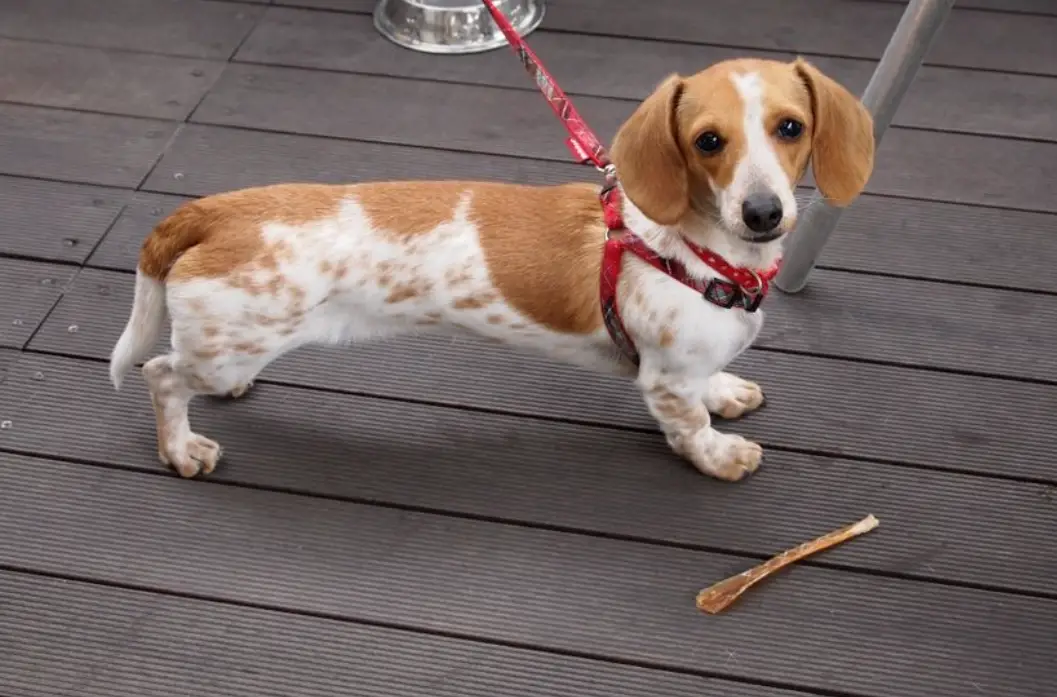A Piebald Dachshund is a version of the breed with a specific coat pattern, characterised by patches of color on a white background.
This pattern is similar to that found in some horses and cows and usually relates to black or brown on white.
That’s no surprise when you consider the term “piebald” originates from “pie” (derived from magpie, a bird with black and white plumage) and “bald”, meaning a white patch or spot.
The piebald pattern in Dachshunds is caused by a specific genetic variation and is distinct from dapple or merle patterns, which also occur in Dachshunds and involve a different genetic mechanism.
Piebalds don’t require any special attention beyond what a typical Dachshund would need. This includes regular exercise, a balanced diet, and routine veterinary check-ups.
However, due to their long backs and short legs, Dachshunds, in general, are prone to spinal issues, so it’s important to monitor their activity and avoid situations where they might injure their spine.
Despite their small size, they can be quite stubborn and have a strong hunting instinct, traits that can be managed with proper training and socialization from a young age.
Piebald Dachshund vs Standard Dachshund
The primary difference between a Piebald Dachshund and a Standard Dachshund is the coat pattern. The distinction is purely aesthetic and does not generally affect the dog’s health, temperament, or care requirements. Here’s a comparison of the two:
Piebald Dachshund
Coat Pattern: Distinctive for its piebald pattern, which consists of a white base coat with patches of color (commonly black or brown). This pattern is caused by a specific genetic variation.
Rarity: The piebald pattern is less common compared to the standard solid or two-tone colors seen in Dachshunds.
Health Considerations: Same as a standard Dachshund, but potential buyers should be aware of ethical breeding practices to avoid health issues related to coat color genetics, such as deafness, which is rare but can be associated with white coat color in some breeds.
Standard Dachshund
Coat Pattern: Typically solid or two-toned, without the distinct white and colored patchwork pattern of the piebald. Standard colors include red, cream, black, chocolate, and tan, among others.
Popularity: The standard color patterns are more common and widely recognized in the breed.
Health Considerations: Like all Dachshunds, they are prone to spinal issues due to their long backs and short legs, along with other potential hereditary health problems.
Common Traits (Both Types)
Both come in three sizes – standard, miniature, and “kaninchen” (rabbit size), mainly based on the dog’s chest circumference.
Known for being playful, courageous, and sometimes stubborn. They are also known for their strong hunting instinct.
Require regular exercise, a balanced diet, and routine veterinary check-ups. Due to their spinal structure, activities that can strain their backs should be avoided.
Early socialization and consistent training are important, as they can be strong-willed.
Do Piebald Dachshunds Have Long Hair?
Like other dachshunds, they can have varying coat lengths and the breed comes in three coat types: smooth, long-haired, and wire-haired.
The piebald pattern refers to the coloration of the coat, not its length. Therefore, a Piebald Dachshund can have a long coat, a smooth or short coat, or a wire-haired coat.
Long-Haired Piebald Dachshund
These dogs have a silky, slightly wavy coat that is longer on the neck, chest, underbody, ears, and behind the legs.
The long hair gives a flowing appearance. In a long-haired Piebald Dachshund, the pattern would be displayed in this longer fur.
Smooth-Haired Piebald Dachshund
This variety has a short, dense, and shiny coat. The piebald pattern on these dogs would be clearly visible and easy to maintain due to the shortness of the fur.
Wire-Haired Piebald Dachshund
Wire-haired Dachshunds have a thick, rough coat with a softer undercoat. The piebald pattern can also be found in this coat type, though it might be less distinct due to the texture of the fur.
What Health Problems Are Piebald Dachshunds Known For?
Piebald Dachshunds, like other Dachshunds, can suffer with certain health issues although it’s important to note that the coat pattern itself is not generally linked to specific health problems beyond those common to the breed.
Here are some health concerns to be aware of:
Intervertebral Disc Disease (IVDD): Dachshunds, due to their long backs and short legs, are particularly prone to spinal problems, including IVDD.
This condition involves the discs between the vertebrae either bulging or herniating into the spinal cord space, causing pain, nerve damage, and potentially paralysis.
Obesity: Dachshunds can easily become overweight, which exacerbates the risk of spinal problems and other health issues like diabetes.
Dental Issues: Their small mouths can lead to overcrowded teeth, increasing the risk of dental problems such as gum disease and tooth decay.
Eye Problems: They may be prone to certain eye conditions like progressive retinal atrophy, cataracts, and glaucoma.
Ear Problems: With their long, floppy ears, Dachshunds are more prone to ear infections, which require regular monitoring and cleaning.
Patellar Luxation: This is a condition where the kneecap dislocates out of its normal position.
While the piebald pattern is not directly associated with specific health issues, all potential Dachshund owners should be aware of the general health risks of the breed.
When adopting a Piebald Dachshund, it’s crucial to work with a reputable breeder who tests for common health issues in the breed and can provide health clearances for the puppy’s parents.
Regular veterinary check-ups, a proper diet, and adequate exercise can help manage and prevent some of these health problems.
Where Can You Buy Piebald Dachshund Puppies?
It’s crucial to choose a reputable source to ensure that the puppy is healthy and has been bred and raised in a responsible and ethical manner.
To buy a Piebald Dachshund puppy, there are several avenues you can explore.
Reputable Breeders
Look for breeders specializing in Dachshunds, preferably those with experience in Piebald Dachshunds. Reputable breeders should:
- Provide health clearances for both parents, proving they’ve been tested for common genetic diseases.
- Allow you to visit and see the conditions in which the puppies are raised.
- Show knowledge about the breed and offer guidance on caring for your puppy.
- Ask you questions to ensure their puppies are going to a good home.
- Breed Clubs and Organizations: Contact breed clubs or national organizations like the Dachshund Club of America, which might have listings of reputable breeders or upcoming litters.
Dog Shows or Events
Attending local dog shows or events can be a good way to meet breeders and see their dogs in person.
Online Resources
There are various online platforms where breeders list their puppies. Be cautious and conduct thorough research to ensure the breeder is reputable.
Avoid buying from websites that have multiple breeds available or do not provide detailed information about the puppies’ health and living conditions.
Rescue Organizations and Shelters
While it might be more challenging to find a Piebald Dachshund through a rescue or shelter, it’s worth checking. Sometimes specific breed rescues have Dachshunds available for adoption.
It’s important to avoid puppy mills and pet stores that may not prioritize the health and well-being of their animals. A good breeder will be as interested in the suitability of the home as you are in the puppy.
Always visit the breeder in person, see how the puppies interact with their littermates and environment, and ask lots of questions about the puppy’s health, temperament, and care requirements.
Main Image: Piebald Dachshund / Facebook

